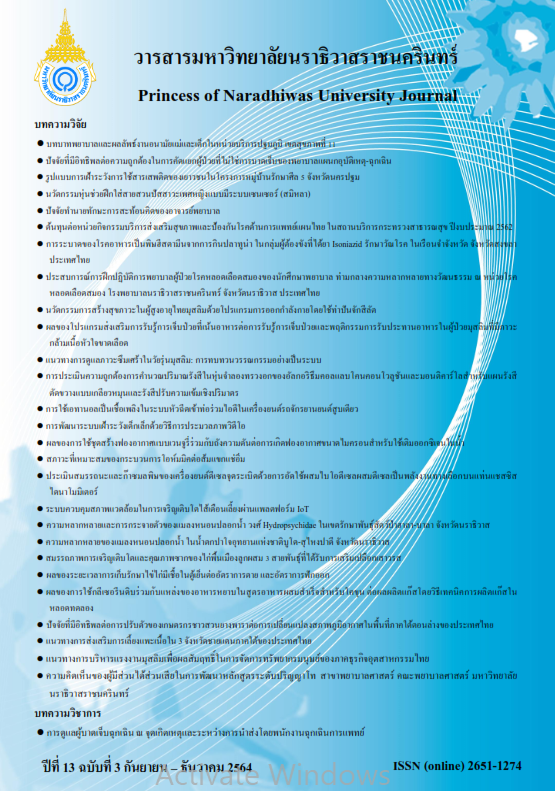Effect of Using Venturi-type Bubble Generator with Pressure Tank on Micro Bubble Generation for Aeration
Keywords:
Venturi-type bubble generator with pressure tank, Microbubble generator, OxygenationAbstract
Usage of air diffuser or jet aerator was a typical technique that used for oxygenation process. However, the occurred bubbles were unstable, rapidly floated to the water surface and small amount of dissolved oxygen level. The objective of this study was to increase the efficiency of air bubble generator to produce the microbubble applying the venturi principle and pressure. Venturi-type microbubble generator at various pressure (1, 2, 3, 4, 5 and 6 kg/cm2) and air diffuser were studied and compared. It was found that, the air bubbles from venturi-type microbubble generator without pressure and air diffuser were larger than 1 mm. Because of the unstable bubbles, the water only contained dissolved oxygen level at 3.72 mg/l. Whereas, the size of bubbles was decrease with increasing the pressure level. Venturi-type microbubble generator with pressure at 6 kg/cm2 generated the microbubble size 46.13 µm, the water contained dissolved oxygen level at 7.40 mg/l which had the highest rate of dissolved oxygen level. Moreover, venturi-type microbubble generator with pressure at 6 kg/cm2 also had the highest in the oxygen transfer coefficient, oxygenation capacity, oxygen transfer rate and aerator efficiency which were 6.01 hr-1, 33.20x10-4 mg O2/hr, 3.70 mg O2/kW/hr and 6.90%, respectively.
References
Aan, D., Wiratni, W., Tontowi, A., Indarto, I., & Iriawan, A.G.W. (2015). The Implementation of a Developed Microbubble Generator on the Aerobic Wastewater Treatment. International Journal of Technology, 5, 327-333.
Agarwal, A., Ng, W.J., & Liu, Y. (2011). Principle and applications of microbubble and nanobubble technology for water treatment. Chemosphere, 84, 1175-1180.
Akhtar, M.S., Rajesh, M., Ciji, A., Sharma, P., Kamalam, B.S., Patiyal, … Sarma, D. (2018). Photo-thermal manipulations induce captive maturation and spawning in endangered golden mahseer (Tor putitora): A silver-lining in the strangled conservation efforts of decades. Aquaculture, 497, 336-347.
Bagatur, T. (2014). Evaluation of plant growth with aerated irrigation water using venturi pipe part. Arabian Journal for Scicnce and Engineering, 39, 2525-2533.
Dahrazma, B., Naghedinia, A., Gorji, H.G., & Saghravani, S.F. (2019). Morphological and physiological responses of Cucumis sativus L. to water with micro-nanobubbles. Journal of Agricultural Sciance and Techmology, 21, 181-192.
Kaya, Y., Bacaksiz, A.M., Bayrak, H., Gönder, Z.B., Vergili, I., Hasar, H., & Yilmaz, G. (2017). Treatment of chemical synthesis-based pharmaceutical wastewater in an ozonation-anaerobic membrane bioreactor (AnMBR) system. Chemical Engineering Journal, 322, 293-301.
Li, P. (2006). Development of Advanced Water Treatment Technology using Microbubbles. Dissertation of Keio University, Japan.
Liu, C., Hiroshi, T., Zhang, J., Zhang, L., Yang, J., Huang, X., & Kubota, N. (2013). Successful application of shirasu porous glass (SPG) membrane system for microbubble aeration in biofilm reactor treating synthetic wastewater. Separation and Purification Technology, 103, 53-59.
Mitra, S., Daltrophe, N.C., & Gilron, J. (2016). A novel eductor-based MBR for the treatment of domestic wastewater. Water Research, 100, 65-79.
Moutafchieva, D., Popova, D., Dimitrova, M., & Tchaoushev, S. (2013). Experimental determination of the volumetric mass transfer coefficient. Journal of Chemical Technology and Metallurgy, 48, 351-356.
Nadayil, J., Mohan, D., Dileep, K., Rose, M., & Parambi, R.R. (2015). A Study on effect of aeration on domestic wastewater. International Journal of Interdisciplinary Research and Innovations, 3, 10-15.
Nakatake, Y., Kisu, S., Shigyo, K., Eguchi, T., & Watanabe, T. (2013). Effect of nano air-bubbles mixed into gas oil on common-rail diesel engine. Energy, 59, 233-239.
Onari, H., Saga, T., Watanabe, K., Maeda, K., & Matsuo, K. (1999). High functional characteristics of micro-bubbles and water purification. Resour Process, 46, 238-244.
Panich, P., Tawonsri, P., Palasai, W., & Srichai, P. (2020). Application of Venturi Type Bubbles Generator Combine with Pressure Tank on Small Bubbles Generation for Aeration. Conference of Mechanical Engineering Network of Thailand, 34, 861-869.
Parmar, R., & Majumder, S.K. (2013). Microbubble Generation and Microbubble-aided Transport Intensification – A State-of-the-art Report, Chemical Engineering and Process: Process Intensification, 64, 79-97.
Sadatomi, M., Kawahara, A., Matsuura, H., & Shikatani, S. (2012). Microbubble generation rate and bubble dissolution rate into water by a simple multi-fluid mixer with orifice and porous tube. Experimental Thermal Themal and Fluid Science, 41, 23-30.
Terasaka, K., Hirabayashi, A., Nishino, T., Fujioka, S., & Kobayashi, D. (2011). Development of microbubble aerator for waste water treatment using aerobic activated sludge. Chemical Engineering Science, 66, 3172-3179.




